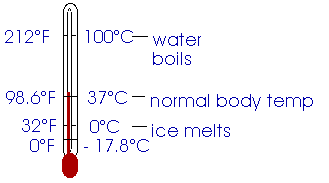

Ch 19, Temperature Thermometers and the Celsius Temperature Scale
The thermometer you most readily think of is probably a liquid-in-glass thermometer like the one sketched here. Mercury or colored alcohol is contained in a bulb at the base of a thin tube of glass. The change in the length of the glass tube with variation in temperature is so small that we can ignore that and concentrate on the expansion of the volume of liquid in the bulb. As this volume expands it forces the liquid up into the glass tube.
Calibrating or creating a temperature scale with 0-degrees for the ice point of water and with 100-degrees for the steam point of water (both at 1 atm pressure) is the basis of the Celsius scale. In the past, this was also known as the centigrade scale.
In the United States, it is still common to use the Fahrenheit scale. On the Fahrenheit scale, water freezes at 32oF (0oC) and water boils at 212oF (100oC). There are interesting stories as to how Fahrenheit may have devised his thermometer scale. It, too, may have been a "centigrade" scale with 0oF the lowest temperature Fahrenheit could obtain with water, ice, and salt and 100oF his not-quite-right measure of human body temperature.

Conversion from Celsius to Fahrenheit[ It is sometimes helpful to distinguish between an actual temperature, such as 100oC, and a temperature difference, such as 15 Co, by using oC for the actual temperature and Co for the temperature difference. While this is no "big deal", it is sometimes helpful. ]
100 Co = 180 Fo 1 Co = (9/5) Fo
1 Fo = (5/9) Co
TC = (5/9) (TF - 32)
TF = (9/5) TC + 32
Listening to an international news segment on CNN, you hear that the local temperature is 42oC. What is that on the Fahrenheit temperature scale?
(c) Doug Davis, 2002; all rights reserved